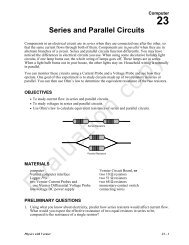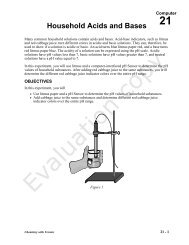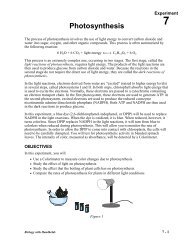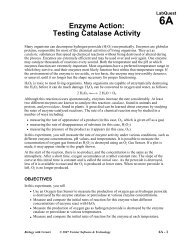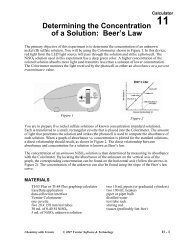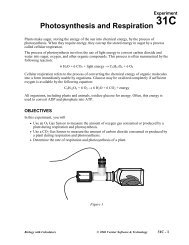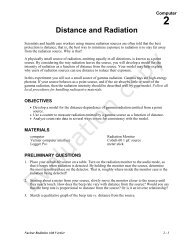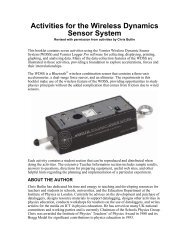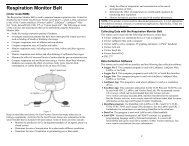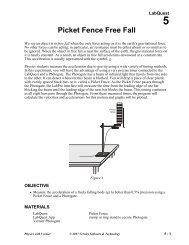No Dumping - Vernier Software & Technology
No Dumping - Vernier Software & Technology
No Dumping - Vernier Software & Technology
Create successful ePaper yourself
Turn your PDF publications into a flip-book with our unique Google optimized e-Paper software.
Case File 8<strong>No</strong> <strong>Dumping</strong>:Using soil characteristics to link suspects to a crime sceneUse physical and chemical characteristics of soils to identify a soil samplefrom a certain area.Police ReportEarly Saturday morning, two local teenagers called policeafter observing a large, dark blue pickup truck dumpingtoxic materials in City Park. Due to the dim morninglight, the boys were unable to see a license plate number.They did, however, recognize the make and model of thepickup truck. Police quickly apprehended four suspectswho drive trucks of this make and model.All four suspects deny having been anywhere near CityPark in recent weeks.Although tire tracks were found at the scene, the treadpatterns were smudged. <strong>No</strong> toxic residue was found in thepayloads of any of the trucks, but police were able tocollect soil samples from underneath the bumpers.Police suspect that an organized crime network isillegally dumping toxic material in exchange for largepayoffs from local chemical company ZenCorp. We mustidentify the perpetrators in order to crack this ring.Dump site at City ParkSuspect 1 rear bumperSuspect 2 rear bumperSuspect 3 rear bumperSuspect 4 rear bumperEvaluation copy
<strong>No</strong> <strong>Dumping</strong>Case8OBJECTIVES• Identify characteristics of different soils to demonstrate that a suspect has been at a scene.• Use characteristic properties to identify a sample.• Measure the pH of soils.• Measure the water absorbency of soils.• Measure the conductivity of soils.MATERIALScomputerLogger Pro<strong>Vernier</strong> computer interface<strong>Vernier</strong> pH Sensor<strong>Vernier</strong> Conductivity Probemagnifying glasscoarse filter papers (12.5 cm diameter)distilled waterlint-free tissueswash bottle (with distilled water)PROCEDURE100 mL graduated cylinderfive 250 mL beakers5 spoons or weighing papers400 mL beaker50 mL beakerstirring rodlarge funnelbalancegogglesfive 100 g soil samplesCAUTION: Obtain and wear goggles during this experiment. Tell your teacher right away ifany spills or accidents occur.Part I Preparing the Soil-and-Water Mixtures1. Prepare mixtures of water and soil. For each sample, complete the following steps:a. Label a 250 mL beaker with the sample number.b. Using a balance, measure 50 g of the soil sample and place it in the labeled beaker. <strong>No</strong>te:To avoid contaminating the other samples, use a different spoon or weighing paper foreach sample.c. Measure 100 mL of distilled water in the graduated cylinder. Add the water to the soil inthe beaker.d. Stir the mixture thoroughly with the stirring rod. Repeat stirring once every 3 minutes for15 minutes.e. After the final stir, let the mixture settle for 5 minutes before beginning to take readings.<strong>No</strong>te: To avoid contaminating the other samples, rinse the stirring rod with distilled waterbetween soil samples.Evaluation copyPart II Measuring the pH of the Samples2. Connect the pH Sensor to Channel 1 of the interface. <strong>No</strong>te: For this experiment, your teacheralready has the pH Sensor in a pH soaking solution in a beaker. Be careful not to tip over thebeaker when you connect the sensor to the interface.Forensics with <strong>Vernier</strong> 8 - 1
Case 83. Prepare the computer for data collection by opening the file “08A Soil Identification” fromthe Forensics with Computers folder of Logger Pro.4. Use the pH Sensor to determine the pH of the solution in each sample beaker.a. Rinse the tip of the pH Sensor with distilled water from the wash bottle and place it intothe liquid in the beaker containing sample 1. Gently swirl the sensor in the solution. Becareful not to let the tip of the sensor touch any solid material at the bottom of the beaker.b. When the pH reading stabilizes, record the pH value in the Evidence Record.c. Repeat Steps 4a and 4b for each remaining soil sample.5. When you are finished, rinse the pH Sensor with distilled water and return it to its storagecontainer.Part III Testing the Conductivity of the Samples6. Disconnect the pH Sensor from the interface and connect the Conductivity Probe toChannel 1. Set the switch on the probe to the 0–20,000 µS/cm setting.7. Prepare the computer for data collection by opening the file “08B Soil Identification” fromthe Forensics with Computers folder of Logger Pro.8. Hold the sensor out in the air and click to zero the Conductivity Probe.9. Collect conductivity data for each sample.a. Place the tip of the probe into the beaker containing sample 1. The hole near the tip of theprobe should be completely covered by the liquid. Gently swirl the probe in the solution.b. Once the conductivity reading has stabilized, record the value in your Evidence Record.c. Rinse the Conductivity Probe thoroughly with distilled water from the wash bottle beforecollecting data for the next sample. Blot the outside of the probe end dry using a tissue. Itis not necessary to dry the inside of the hole near the probe end.d. Repeat Steps 9a–9c for each of the remaining samples.10. Empty the remaining liquid from the beakers as directed by your teacher. Rinse and dry thebeakers.8 - 2 Forensics with <strong>Vernier</strong>
Part IV The Physical Appearance of the Samples<strong>No</strong> <strong>Dumping</strong>11. For each sample, use the balance to measure out 50 g on a piece of filter paper labeled withthe sample number.12. Examine the samples through the magnifying glass. In the Evidence Record, make a sketch ofeach sample and write down some notes about its appearance.Part V Determining the Water Absorbency of the Samples13. Determine how well each sample absorbs water.a. Carefully lift the sample 1 filter paper and soil that you prepared in Step 11.b. Place the filter paper and soil into a funnel.c. Have your lab partner hold the funnel over a 400 mL beaker.d. Measure 100 mL of distilled water in the graduated cylinder, and pour it through the soil.Collect any water that drains through in the beaker.e. Let the sample drip for 60 seconds.f. Pour the water from the beaker into the 100 mL graduated cylinder.g. Subtract the volume of water in the graduated cylinder from the 100 mL you poured intothe soil. This is the amount of water absorbed by the soil. Write this amount in the WaterAbsorbency column of your Evidence Record.h. For each remaining soil sample, empty the funnel, 400 mL beaker, and graduated cylinderand repeat Steps 13a–13g.EVIDENCE RECORDSampleGeneralAppearanceWaterAbsorbancy(mL/50 g)pHConductivity(µS/cm)1234Crime SceneForensics with <strong>Vernier</strong> 8 - 3
Case 8Sketch of Physical AppearanceCASE ANALYSIS1. What is the range of pH that you found in the five soil samples?2. What does a high pH mean, and what does a low pH mean?3. What can cause a soil to become acidic or basic?4. What is the range of conductivity that you found?5. What does a high conductivity indicate about the soil?6. Why is it important to know the pH and the conductivity of a soil if you want to know howsalty the soil is?7. What is the range of water absorbency that you found?8. What types of soils have a high water absorbency, and what types of soils have a low waterabsorbency?9. How can an investigator use the physical appearance of a soil sample to link a suspect to avictim or crime scene?10. What tools can a forensic scientist use to identify and match soil samples?11. Based on your observations, were any of the suspects’ vehicles present at the crime scene? Ifso, which ones? Explain your answer.8 - 4 Forensics with <strong>Vernier</strong>
<strong>Vernier</strong> Lab Safety Instructions DisclaimerTHIS IS AN EVALUATION COPY OF THE VERNIER STUDENT LAB.This copy does not include:• Safety information• Essential instructor background information• Directions for preparing solutions• Important tips for successfully doing these labsThe complete Forensics with <strong>Vernier</strong> lab manual includes 14 labs and essential teacherinformation. The full lab book is available for purchase at:http://www.vernier.com/cmat/fwv.html<strong>Vernier</strong> <strong>Software</strong> & <strong>Technology</strong>13979 S.W. Millikan Way • Beaverton, OR 97005-2886Toll Free (888) 837-6437 • (503) 277-2299 • FAX (503) 277-2440info@vernier.com • www.vernier.com




